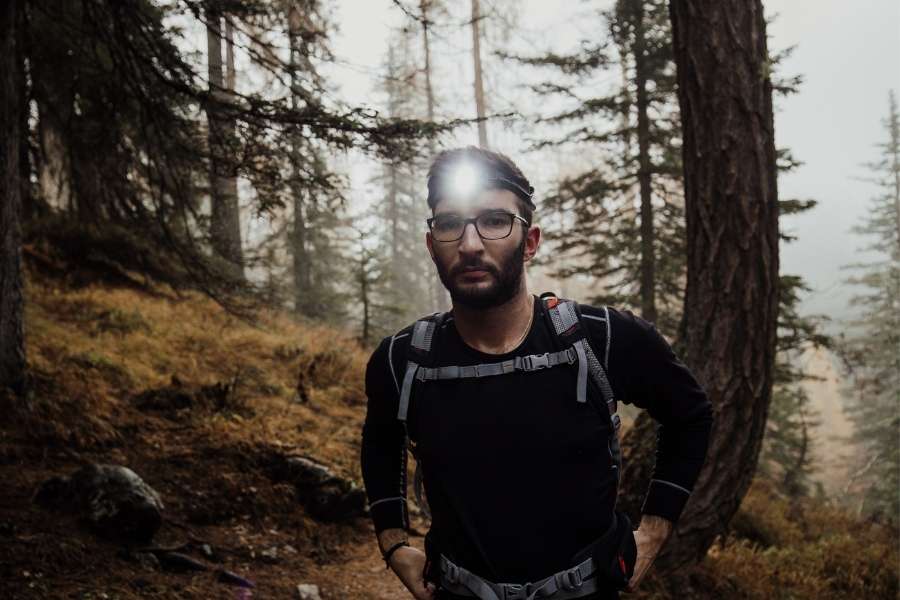To choose a good headlamp, decide what you need it for. For hiking, jogging, night cycling, or just outdoor excursions so you don’t get lost in the tent at night. The more difficult the task, the more closely you need to study the characteristics of the head lamp.
General characteristics
Power (in lumens) – the more powerful the flashlight, the brighter it shines (provided that the battery is fully charged).
Light beam range (in meters) – determines the distance that the flashlight illuminates. Light can be near, far, and mixed. The middle one is suitable if you need to set up a camp in the dark, cook food, look at the map. The far one is needed by cyclists, runners, climbers – it illuminates the road or wall far ahead. Mixed is convenient in a movement when you need to simultaneously see what is ahead and what is under your feet.
Weight (in grams) – the lighter the flashlight, the more comfortable it is and the less it feels on the head. Headlamps weigh 50-150 grams, but they are also heavier. Weight depends on the number of functions, the type of attachment (elastic band, strap, cord), the type and number of batteries (rechargeable battery, batteries, or a separate battery pack). The lightest flashlights are the simplest ones, with 1-2 modes.
The degree of protection of the case against moisture and dust (index IPXX) – the first X after IP means protection against dust, the second – protection against water. If only one number is specified (for example IPX4), it means that the flashlight has passed the splash test only, and the dustproof test has not been carried out. Read more about what the index numbers mean – in the picture.
The material – the body is usually plastic, and the forehead strap is made of an elastic band or a stretching strap.
Operating time (in hours) – the brighter the flashlight, the faster it eats up the battery. Some models are capable of operating at multiple power levels and dimming depending on the environment.
Operating modes – in fact, there are four of them: economical, standard, maximum power mode, and flashing (strobe). In the presence of a red LED, a dipped red light and a red flashing light are added. Depending on the model, one flashlight may contain all these modes, or only 1-2.
Battery type – rechargeable battery or battery.

How to choose a flashlight for different activities
The flashlight may have additional functions, for example, an emergency beacon, an SOS signal, a strobe, a magnet on the back cover (to attach the flashlight to metal parts of a car or bicycle), a charge indicator, additional mounts, etc.
It is worth choosing a flashlight for specific tasks and paying attention to those characteristics that are more important for your goals. For example, tourists do not need an ultra-high power of a flashlight for simple hiking trips, but lightness and the longest possible operating time are important. Trail runners, on the other hand, are concerned with the brightness and range of the beam. Cavers prioritize impact resistance and water resistance. We will tell you how to choose a flashlight for different types of activities.
For runners and cyclists
A headlamp is a must-have for trails, rogaining, orienteering, cycling – wherever you run or ride early in the morning before dawn, at dusk, or overnight.
For mountain hikes and mountaineering
Ascents usually begin before dawn. From a distance, a group of climbers looks like a thin glowing thread – each has a headlamp. During the ascent, it is important that the space under your feet or under your arms is well lit: this way you will immediately notice a crack in a glacier, a hole, a rock, or a necessary ledge that you need to grab onto.
For trekking and camping
In trekking, simple hiking, and outdoor recreation, a flashlight is needed sporadically and mainly in the camp. An exception is if you did not have time to reach the parking lot before dark and you need to highlight the trail. The requirements for such lamps are less stringent. For example, high power is not necessary: to pitch a tent and do business in the camp, a wide scattered beam is enough. If you need a flashlight for trekking with overnight stays in shelters or campsites where there is electricity, take a closer look at models with a battery – you don’t have to carry an extra load of batteries.
For speleology
Cavers have specific conditions, which means the requirements for lanterns too. Cave lanterns must be able to withstand constant wall impact, dampness, splashing, and even swimming if required.
Here’s what is required of a caving headlamp:
- The ideal protection for these lights is IPX7. This means that the flashlight can be immersed in water up to a meter for 30 minutes.
- Impact resistance. The body must be able to withstand impacts and falls.
- Several modes of operation for different situations: low beam for work, mixed for movement, high beam to see what is there in the depths of the cave.
- Long working time. Good lanterns for cavers hold a charge for 15-20 hours, and when the charge is low, they automatically switch to standby mode. It allows you to hold out for about an hour more and have time to replace the batteries.















